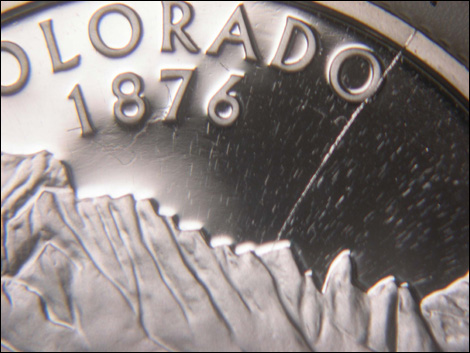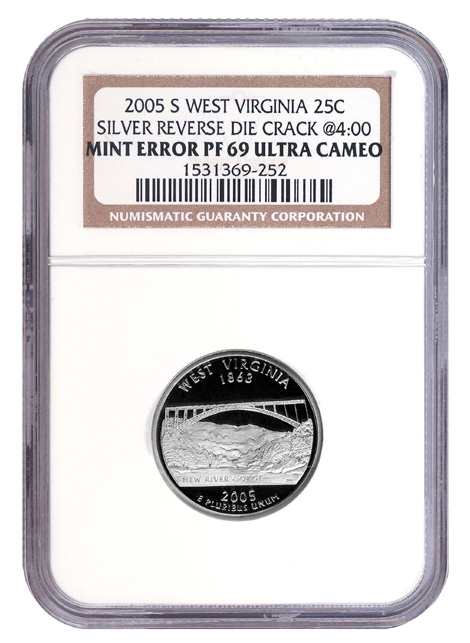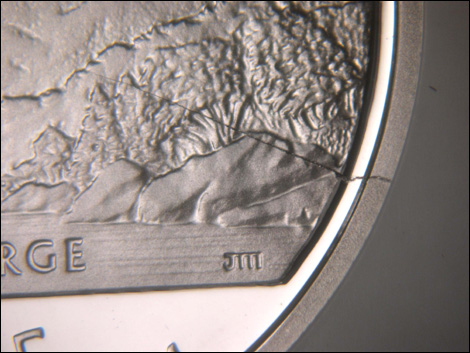 NGC recently identified die cracks on two issues of silver proof States Quarters. The first discovery was on a 2005-S Silver West Virginia Quarter, where a thin crack emerges from the rim at approximately 4:00 and enters the frosted devices. The second error, seen on a 2006-S Silver Colorado Quarter, is slightly more dramatic. It starts at the rim just past 1:00 and runs diagonally through the mirrored field, which makes it readily visible.
NGC recently identified die cracks on two issues of silver proof States Quarters. The first discovery was on a 2005-S Silver West Virginia Quarter, where a thin crack emerges from the rim at approximately 4:00 and enters the frosted devices. The second error, seen on a 2006-S Silver Colorado Quarter, is slightly more dramatic. It starts at the rim just past 1:00 and runs diagonally through the mirrored field, which makes it readily visible.
 A submission consisting of a single 2006 Silver States Quarter Proof Set yielded the discovery of the Colorado Quarter. The West Virginia Quarter, however, was discovered in a submission of 100 Silver States Quarters Proof Sets from 2005, and 62 examples exhibited the error. NGC has graded over 180,000 Silver Proof States Quarters, and, with these pieces included, fewer than 100 such error coins have been identified. NGC graders were surprised to find this error in such quantity. The submitter of the 2005 Proof Sets, Boca Raton, Florida-based coin dealer Finest Known, was also not expecting this unusual trove of errors to be found.
A submission consisting of a single 2006 Silver States Quarter Proof Set yielded the discovery of the Colorado Quarter. The West Virginia Quarter, however, was discovered in a submission of 100 Silver States Quarters Proof Sets from 2005, and 62 examples exhibited the error. NGC has graded over 180,000 Silver Proof States Quarters, and, with these pieces included, fewer than 100 such error coins have been identified. NGC graders were surprised to find this error in such quantity. The submitter of the 2005 Proof Sets, Boca Raton, Florida-based coin dealer Finest Known, was also not expecting this unusual trove of errors to be found.
 When NGC first reported the discovery of a die crack on a proof 2004-S Wisconsin Silver Quarter in August 2005, we commented that several other proof States Quarters were known with die cracks, most notably the prominent ĎSpiked Headí cracks which emerge from the rim at 6:00 on the obverse. These, however, are usually seen on clad (copper-nickel) coins. The appearance of a crack on a silver proof coin is much less frequent. All modern proof coins displaying die cracks are scarce as they are usually caught by the Mintís quality control. As a result of their scarcity, they are all considered collectible.
When NGC first reported the discovery of a die crack on a proof 2004-S Wisconsin Silver Quarter in August 2005, we commented that several other proof States Quarters were known with die cracks, most notably the prominent ĎSpiked Headí cracks which emerge from the rim at 6:00 on the obverse. These, however, are usually seen on clad (copper-nickel) coins. The appearance of a crack on a silver proof coin is much less frequent. All modern proof coins displaying die cracks are scarce as they are usually caught by the Mintís quality control. As a result of their scarcity, they are all considered collectible.
 A die crack occurs when a small break in the die allows metal to flow into the damaged area during striking. On the surface of the coin, this appears as a thin irregular raised line. If the broken die remains in production, more extreme errors can result, including a cud, an unstruck portion of a coinís surface corresponding to an area on the die where a piece has broken away. Die cracks are relatively common on circulation issue coinage and small cracks can fall within accepted tolerances of flaws during coin production. Dies are replaced when a large crack appears. On proof coinage, however, coins with die cracks are deemed outside of acceptable tolerances and, when detected, are culled during quality control.
A die crack occurs when a small break in the die allows metal to flow into the damaged area during striking. On the surface of the coin, this appears as a thin irregular raised line. If the broken die remains in production, more extreme errors can result, including a cud, an unstruck portion of a coinís surface corresponding to an area on the die where a piece has broken away. Die cracks are relatively common on circulation issue coinage and small cracks can fall within accepted tolerances of flaws during coin production. Dies are replaced when a large crack appears. On proof coinage, however, coins with die cracks are deemed outside of acceptable tolerances and, when detected, are culled during quality control.
 These coins are certified by NGC, and the position of the die crack is noted on the certification label. All were graded NGC PF69 ULTRA CAMEO.
These coins are certified by NGC, and the position of the die crack is noted on the certification label. All were graded NGC PF69 ULTRA CAMEO.





